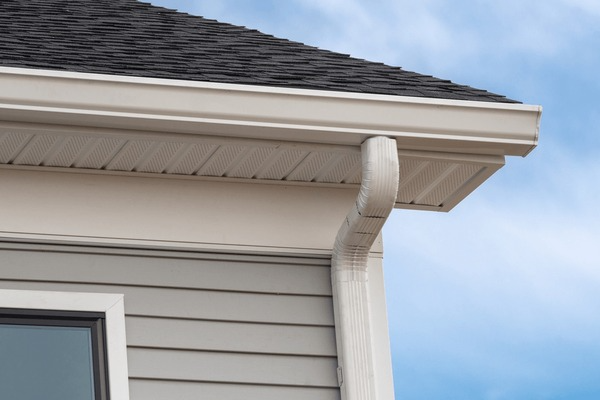Downspout Design That Works: How Many, What Size, and Where

Effective gutter systems do more than collect rainwater. They direct it safely away from a home’s foundation, siding, and landscaping. For homeowners in Land O’ Lakes, where heavy rainfall and seasonal storms are common, proper downspout design plays a central role in protecting property and preserving structural integrity. The number, size, and placement of downspouts determine how efficiently water is carried away from the roof. Understanding the fundamentals of design allows homeowners to make informed decisions when planning or upgrading their gutter installation.
Understanding Roof Area and Rainfall
Every gutter system begins with the roof. The larger the roof surface, the more water it collects during a storm. Roof pitch also matters. A steep roof channels rain more quickly into gutters, creating a higher flow rate that requires adequate drainage.
In Land O’ Lakes, average annual rainfall exceeds fifty inches, which means that local homes must handle significant water volume during intense weather. To estimate drainage needs, professionals calculate the roof’s square footage and multiply it by local rainfall data. This determines how much water may flow into gutters during peak conditions and, in turn, how many downspouts are needed to prevent overflow.
A general guideline is that one downspout should serve every six hundred to eight hundred square feet of roof area. However, homes with steep or complex roof designs may require additional outlets to maintain balance and prevent pooling in gutters.
Determining the Number of Outlets
The number of downspouts is just as critical as their placement. Too few outlets can lead to standing water in gutters, which causes sagging, rust, or leaks along seams. Water that spills over edges can stain siding and erode soil near the foundation.
When planning a new gutter installation, professionals distribute downspouts evenly along the roofline. Each section of gutter should have at least one outlet located at a low point where water naturally collects. On long roof runs, additional downspouts may be required at both ends to divide the flow.
It is also beneficial to consider aesthetics. Downspouts should blend with the structure and avoid obstructing walkways or windows. Strategic placement allows efficient water management without detracting from the appearance of the home.
Choosing Between 2×3 and 3×4 Downspouts
Two standard downspout sizes are commonly used in residential gutter systems: 2×3 inches and 3×4 inches. The choice depends on both roof size and rainfall intensity.
A 2×3 downspout can handle moderate water flow for small or average-sized homes. It is compact and blends easily with trim and siding. However, for larger roofs or areas with heavy rainfall conditions typical in Land O’ Lakes, a 3×4 downspout provides better performance. It can carry roughly twice the water volume of a smaller outlet, reducing the risk of backups and overflow during storms.
Larger downspouts also resist clogging, which means less maintenance over time. When paired with properly sized gutters, they allow smoother water movement and better protection against foundation issues.
Understanding Elbows and Extensions
The configuration of elbows and extensions determines how water exits the downspout and moves away from the structure. Elbows change the direction of flow, guiding water around corners or obstacles. Most downspouts use two or three elbows, depending on wall height and landscaping layout.
Extensions carry water farther from the foundation, often several feet beyond the edge of the home. They can be rigid aluminum pieces or flexible plastic tubing, depending on the homeowner’s preference. Without extensions, runoff may collect near the base of the wall, leading to soil erosion or foundation seepage.
When space is limited, splash blocks provide an alternative. Placed directly under the outlet, they disperse water gently and prevent soil displacement. In some cases, extensions can also connect directly to underground drainpipes, channeling water toward storm drains or rain gardens for environmentally friendly dispersion.
Integrating Downspouts with Drainage Systems
For properties that experience heavy runoff or have minimal grading, tying downspouts into underground drainage systems can improve performance. These systems consist of buried PVC or corrugated pipes that carry water safely to a lower point on the property or into a municipal drain.
Proper slope is critical. The pipe must maintain a consistent downward angle to allow water to flow freely. Cleanout points should be included for maintenance, ensuring that debris can be removed if buildup occurs. When installed correctly, this system prevents standing water near foundations and reduces the chance of basement moisture.
The Value of Professional Gutter Installation
Although some homeowners attempt to install or adjust downspouts on their own, a professional assessment ensures accuracy and durability. Experts calculate roof drainage requirements, recommend proper outlet placement, and use high-quality materials that resist corrosion and wear. They also ensure that joints, elbows, and extensions are sealed securely to prevent leaks and maintain full water flow.
Downspout systems designed with proper size, spacing, and direction protect a home from water damage while maintaining visual appeal. Thoughtful planning and professional installation reduce future maintenance needs and extend the life of the entire gutter system.
For homeowners in Land O’ Lakes seeking dependable performance and precision craftsmanship, MD Seamless Gutters offers expert gutter installation. Their team designs and installs efficient drainage systems tailored to local rainfall patterns, ensuring that every downspout is positioned, sized, and secured for long-lasting protection.



